2024/4/26 (Nishio)
- Used the summary of Fractal Summarizer to introduce a book at an internal study meeting.
- /Nishio/Plurality Study Meeting 1
- Convenient to have a summary at the desired level for the material.
- Identified issues:
- Section breaks in the middle of a chunk.
- The content in the first and second halves differs significantly, causing the latter part to be overlooked.
- However, the latter part serves the role of guiding what the discussion will be about, being the “first paragraph of a new section,” so it was not desirable to discard it.
- Reflections:
- Noticing this issue itself is a benefit of not having a generic summary.
- It might be worth exploring an approach to detect section breaks.
- Proposed methods:
- A rough method could involve “feeding it into LLM to detect breaks.”
- However, considering a faster and more user-friendly mechanism.
- Proposed methods:
- As someone who wants to provide easily readable summaries of books, observing such issues may lead to a desire to control the breaks and regenerate them (though the interface design would be complex).
- Instead of a unidirectional mechanism of “submitting once and reading the generated content,” it seems feasible to create a bidirectional mechanism of “reading the generated content while providing feedback as needed.”
2024/4/24
(Nishio) I was thinking about something else and suddenly thought, if the input at the end is “a variety of people’s opinions,” it could be considered a form of broad listening.
-
Currently chunking based on the order of input, so inputting a variety of opinions with a mixed order might result in a confusing fractal summary.
- I thought of embedding vectors and clustering with varying k in k-means (Nishio).
- I see (blu3mo).
- I thought of embedding vectors and clustering with varying k in k-means (Nishio).
-
Chunking based on meaning rather than order could generate useful summaries to understand a variety of opinions.
-
Leap of thought:
- Can we mimic the structure of a Neural Network encoder?
- Doing weight summaries with LLM instead of linear combinations in each perceptron.
- If we can weight the edges appropriately, we can achieve something close to “meaning-based chunking.”
- Extracting features gradually from input to output.
- Visualizing this process with a Fractal Reader-like UI could ensure traceability.
- The challenge is how to evaluate the state and weight the edges.
- Since backpropagation is not possible, the extent to which mimicking NN is meaningful is unclear.
- Well, LLM itself is a type of NN, so maybe backpropagation is possible?
- Simulation of Research Activities with LLM x Tree Search is doing something similar.
- Addition: Dynamic LLM-Agent Network: An LLM-agent Collaboration Framework with Agent Team Optimization was working on something similar.
- Can we mimic the structure of a Neural Network encoder?
-
It seems plausible to hypothesize that with a “low-cost LLM,” generating high-quality summaries could be cheaper than with a “high-cost LLM.”
- With traceability and the ability to use intermediate layer data for other purposes.
2024/4/23
(Nishio) The concept of fractal summaries was well received internally.
At that time, an impromptu quote came up: “If AI were to create meeting minutes, you would definitely say, ‘Did we really say that?’ So, instead of a ‘black box,’ it’s a ‘summary with traceability’ that allows for in-depth exploration as needed!”
Considerations based on the above content:
- Want to think about how to divide lines (the smallest unit of segmentation).
- Simply breaking lines may lead to undesirable separations.from [/plurality-japanese/Social Hack Day#60 Casual Chat First Half](https://scrapbox.io/plurality-japanese/Social Hack Day#60 Casual Chat First Half)
Fractal Summary
(Claude)
- In the session after the lunch break, a mechanism for fractal summarization developed by blu3mo was introduced and tested by the participants.
- Fractal summarization is a tool that gradually summarizes the main text, allowing readers to delve deeper into the parts they find interesting.
- Participants provided feedback on the quality and clarity of the summaries.
- The need for additional information to complement the content was also discussed.
I would like to know your thoughts on using the Fractal Summary Table of Contents page, or reasons why you didn’t feel motivated to use it! (blu3mo)
- I’m interested in knowing what you found valuable or not valuable. (blu3mo)
Thoughts on the Fractal Summary Table of Contents (healthy-sato)
- I wanted to read a Japanese translation without a summary on a screen where summaries are lined up (imagining a column between Summary 4 and the original text).
- If there was some way to navigate to the corresponding Scrapbox page or make it easier to write feedback after reading, it would be more user-friendly…
- I resolved this by splitting the screen.
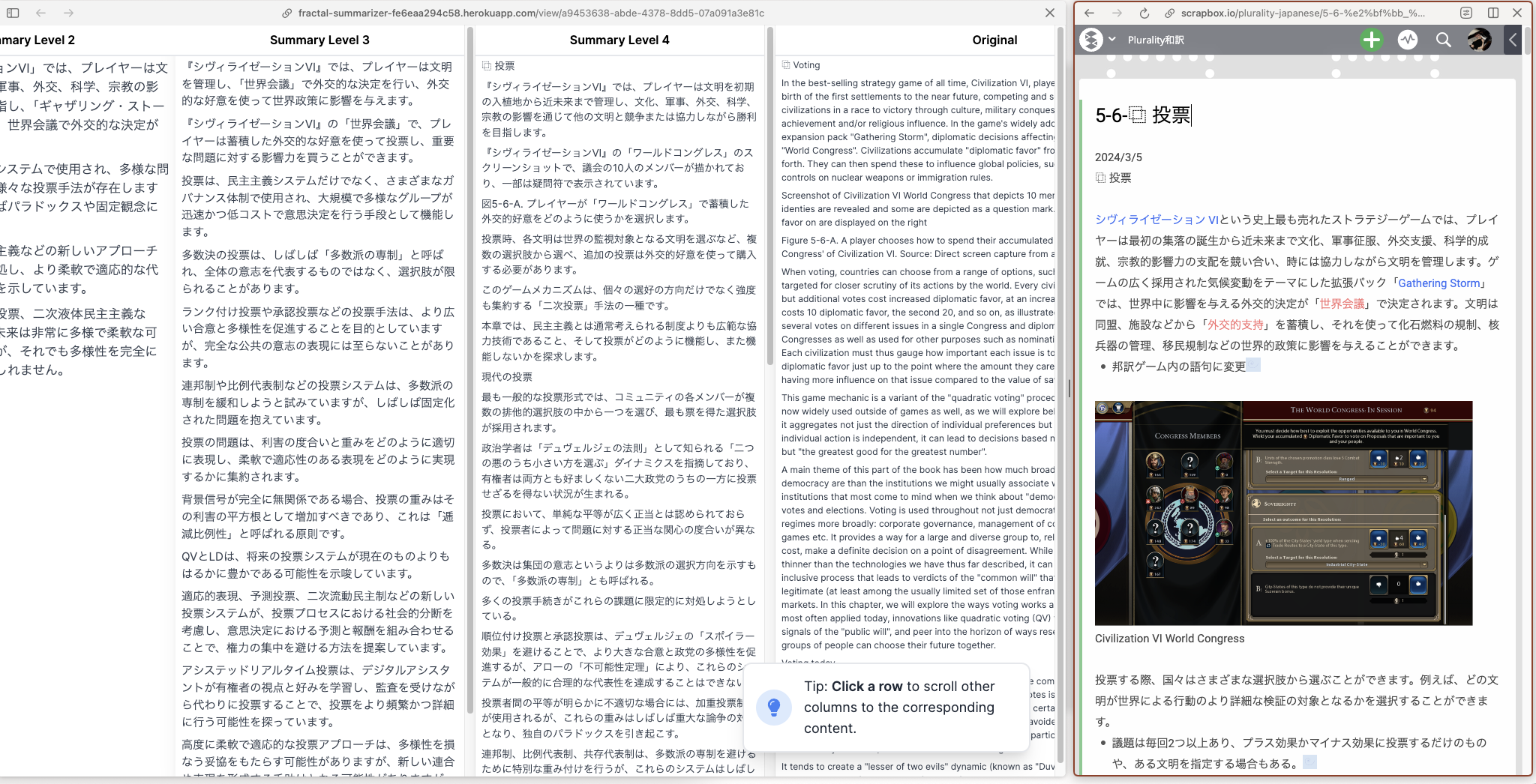
- Mentioning the positioning of each chapter at Summary Level 1-2 might enhance readability.
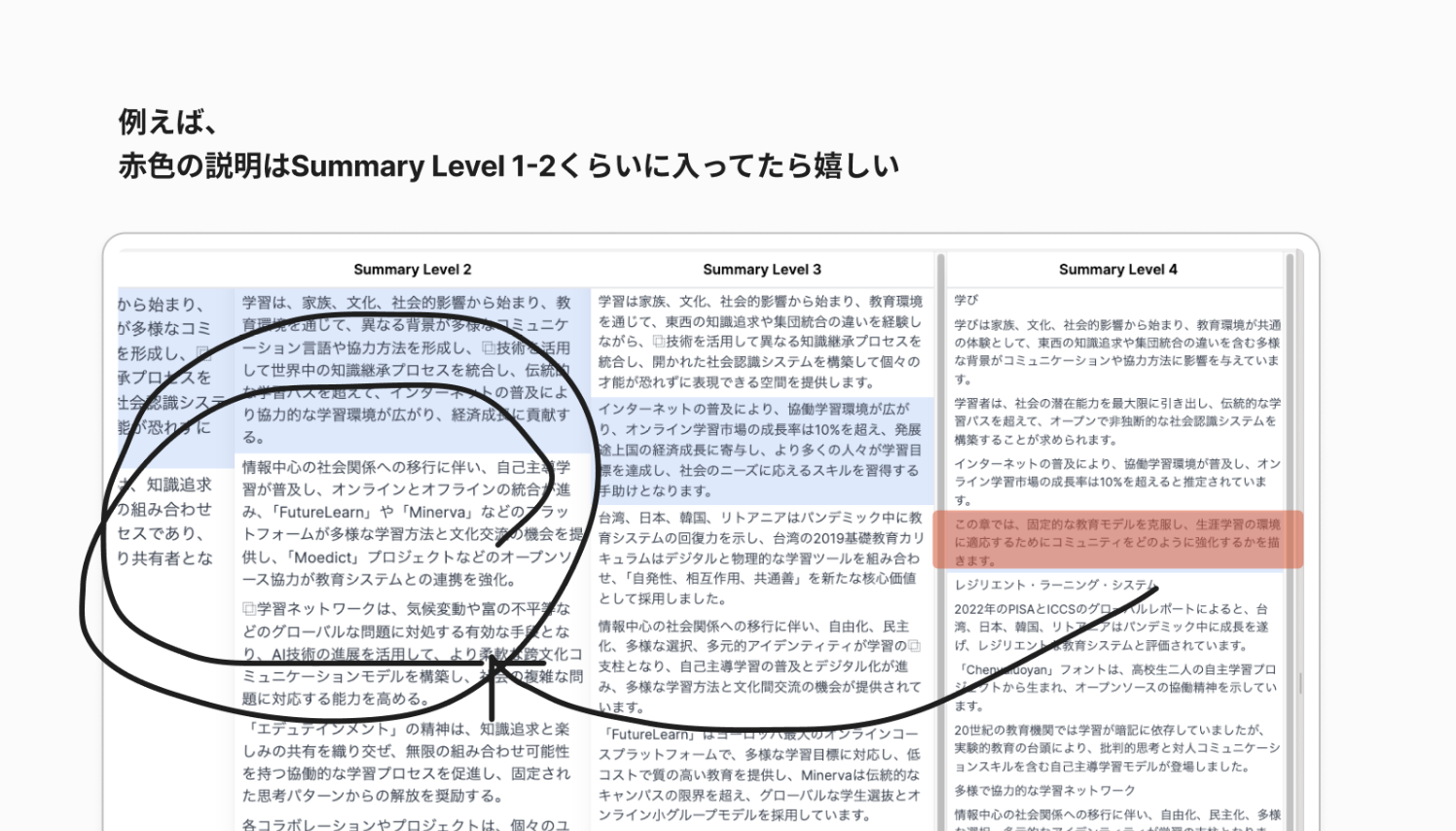
- I see (blu3mo)(blu3mo)
- The structure of the Summary around Level 1-2 seems off, so I’d like to improve that (blu3mo)
I might spend around 1 Pomodoro focusing on reading the Fractal Summary… (nishio)
-
⿻ emphasizes the intersection of individual and group identities and suggests that digital technologies should aim to utilize diversity for development.
- I was intrigued by the “intersection of individual and group identities” and after delving into it, I looked at the summary below and understood.
- I wrote about this on the page for ”individual and group identities“.
- I thought it was nice to have phrases like this that can be kept as a single concept in Scrapbox.
- I wish there was an explanatory page and icon for ”Fractal Summary“.
-
Oliver Wendell Holmes states that the greatest value of civilization is to complicate the means of living and enable a richer life, while Carlo Rovelli explains that reality is not a collection of things but a network of processes, and ⿻‘s approach, which emphasizes complexity, emergence, and multi-layered organizations rooted in science, offers a new perspective on social systems.
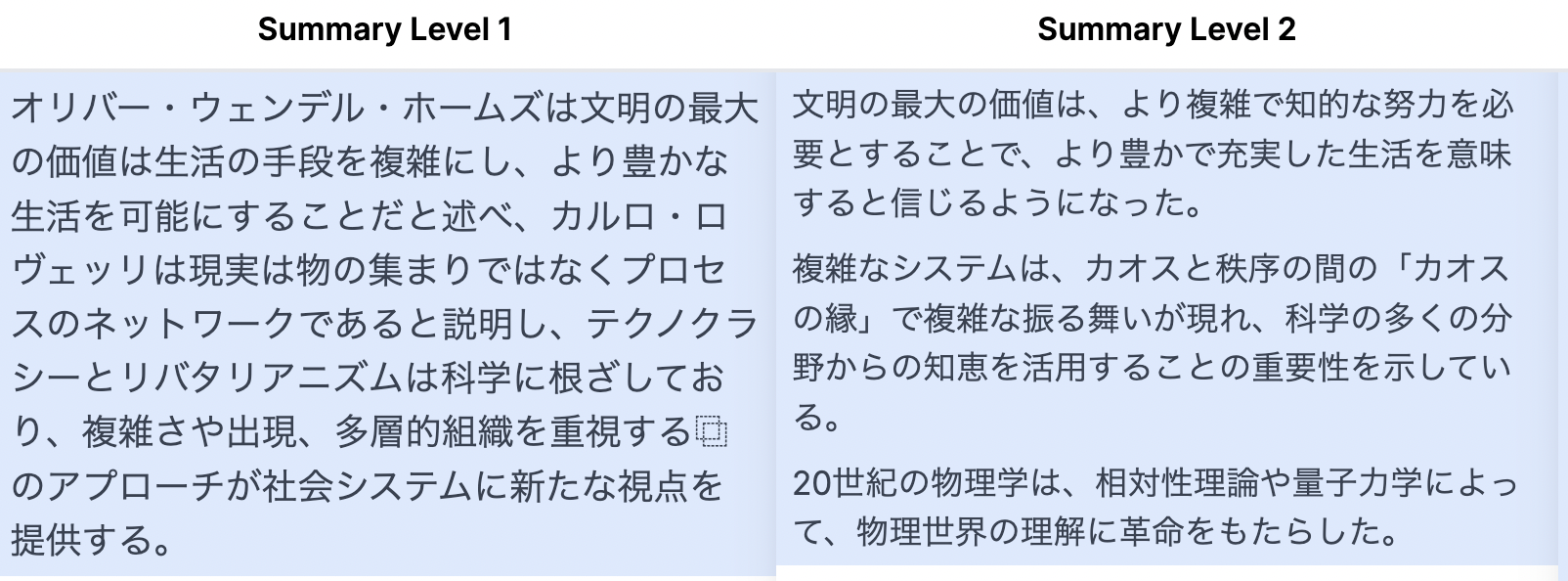
- There’s too much variation in the content, which is confusing.
- The summary here doesn’t feel very good experientially.
- Perhaps the problem lies in the original text having too many leaps in the story, making it more of a list of information…
-
John Dewey states that the new public must destroy old political forms, and pioneers like Henry George, Georg Simmel, and Norbert Wiener presented a vision of a ”connected society” that utilizes the potential for cooperation beyond diversity.
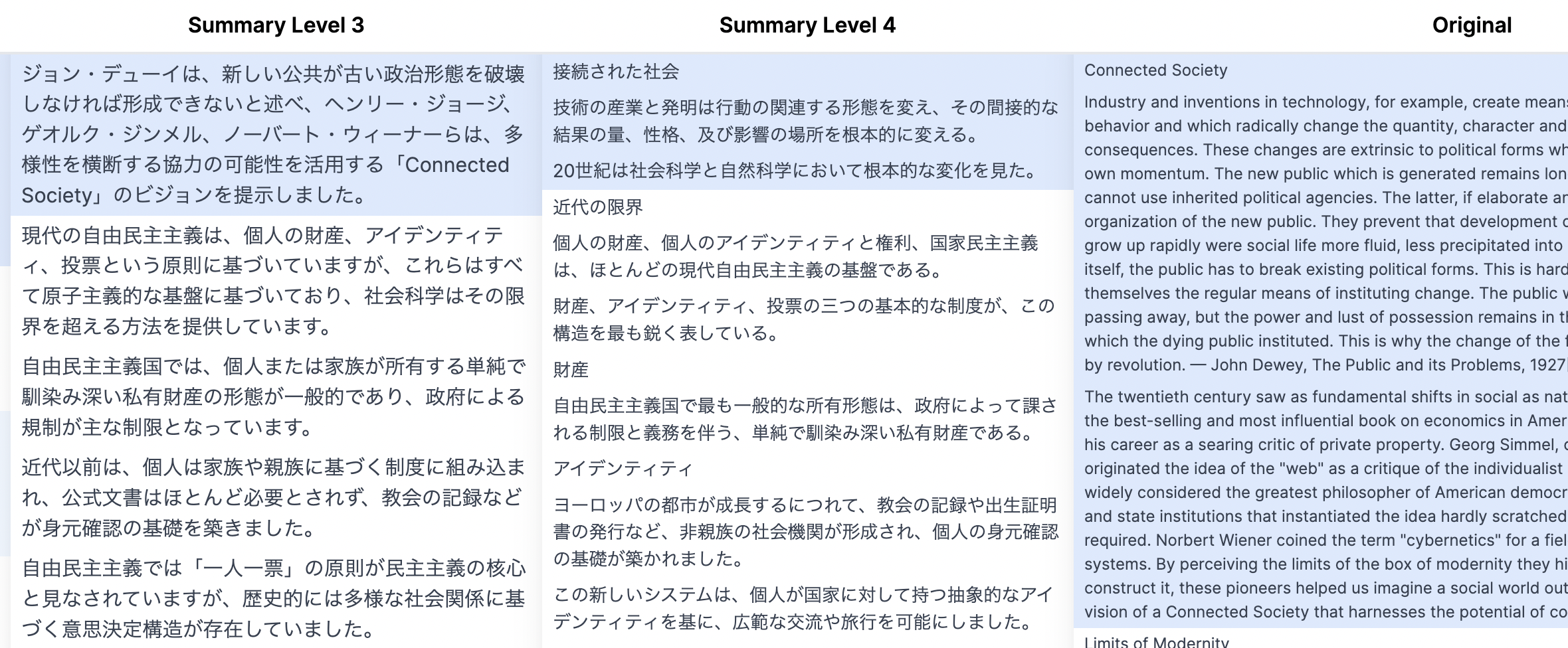
- Hmm, the leaps are…
- Maybe in terms of implementation, Levels 3 and 4 are just operating in parallel with different input ranges, but as users, we expect some continuity between 3 and 4.
- I see (blu3mo)(blu3mo)
- So, should 3 take 4 as input, or should 4 take 3 as input, or maybe iterate a few times to align them…- J.C.R. Licklider argues that decisions regarding the advancement and utilization of computer technology should not only serve the public interest but also provide a means for the public to participate in the decision-making process that shapes the future.
- Suddenly thought, “It would be interesting to gather these kinds of arguments and create a Polis.”
- So, make it possible to jump from each question to each chapter.
-

- There seem to be a lot of discussions about Luna (a fictional character), right?
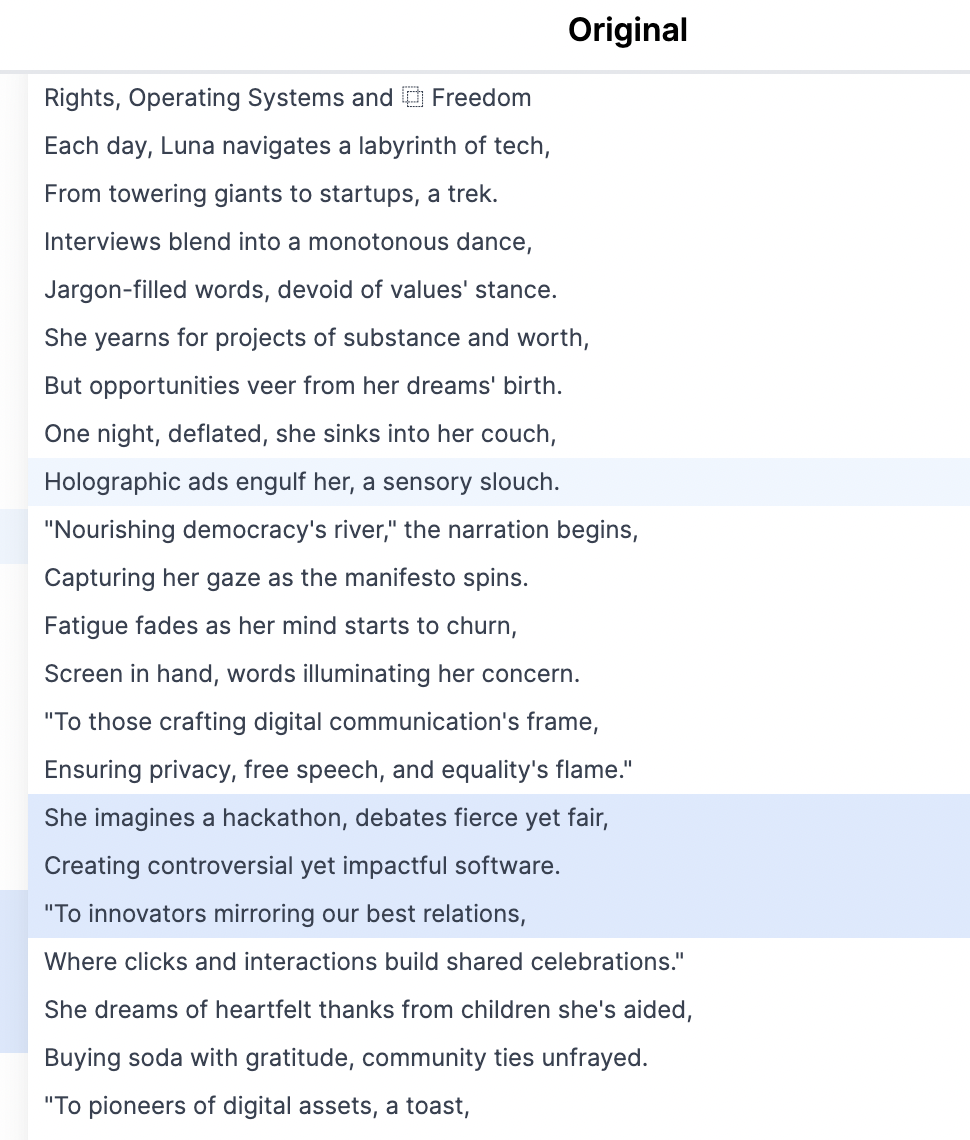
- Oh, I see.
- I might be mistaking line breaks for paragraphs.
- Maybe include a process to combine them up to a certain length if they are too short?
- Or I have data converted from PDF into content per page that I can use?
- There seem to be a lot of discussions about Luna (a fictional character), right?
